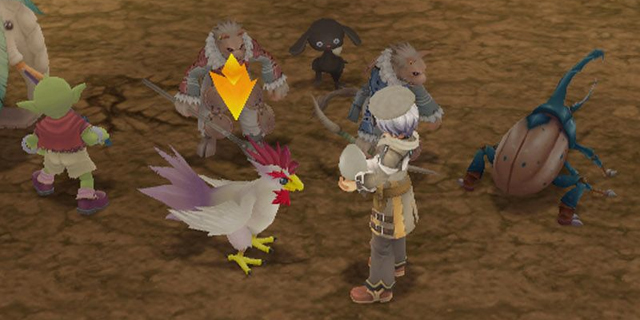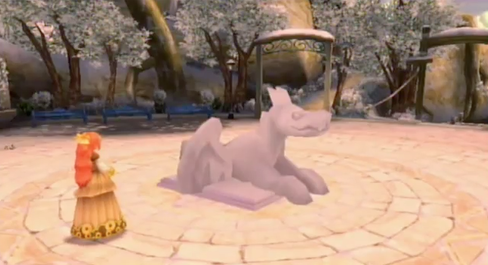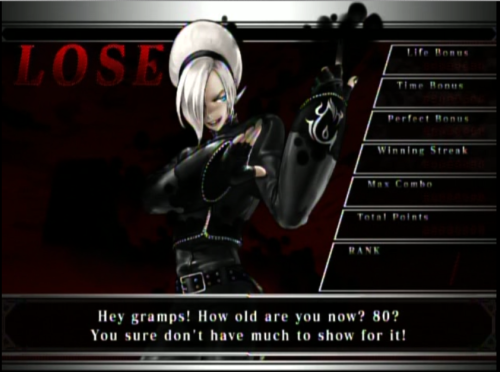With gaming in one of the lowest states it has ever been in,
finding a good Wii game to look forward to has been excruciatingly difficult. These days, all we get is half-assed,
unambitious attempts at making an ordinary game and shovelware made for the blatant
purpose of ripping people off. Gasping
for the genuine greatness we used to have in the year 2009, I, yet again,
reached out and grabbed a copy of Rune Factory: Tides of Destiny, another
recent title to a long-running game franchise that I never played before
because game sequels are almost always better.
The Rune Factory series has been described as Harvest Moon
with JRPG elements and a fantasy setting.
In fact, the full title of the first Rune Factory was Rune Factory: A
Fantasy Harvest Moon, so I can see where that description may have come
from. As for my experience with the
Harvest Moon games, I’d read about them in Nintendo Power years ago, but never
actually played any because frankly they sounded… well… boring. A game about running a farm isn’t exactly the
kind of thing you’d try to advertize to a man who believes Viewtiul Joe to be
the greatest game and anime series ever made, so it seems Natsume opted to take
the Sengoku Basara route and added fantasy and action to make something that
should be a total bore significantly less boring and more compelling. With that, we got the Rune Factory games.
Rune Factory: Tides of Destiny starts with a boy and girl
traveling to the top of an ancient structure.
The boy and girl’s names are Azel and Sonja by default, but I gave the
boy my own name (I probably would have given Sonja the name of my girlfriend if
I ever had one). After a brief run-in
with some monsters, the girl sings to an altar and the two are transported to Fenith Island Fenith Island
But something interesting happened on the way there: Sonja’s
soul is inside of Azel’s body. From
there, a journey begins to find out just what the hell happened and to get
Sonja’s body back while the two get adjusted to their new home on the new
island. The premise may have tipped you
off that anyone who said you can choose to play as a boy or a girl is partially
lying. You can only choose to play as
Sonja after you finish the main story and get her body back, so you’re stuck
with the boy for the long run. This
wasn’t a problem for me, of course, but the female gamers wanting to give the
game a try might be disappointed.
Tides of Destiny’s gameplay essentially consists of 2
halves. The first is on Fenith Island Fenith
Island
Most of what you do on both Fenith Island
While they’re all generally good people, they have flaws
that distinguish them. Everyone has
their own story to tell that you will learn more of the more you talk to them,
which will also raise your relationship values.
When you’ve talked to someone enough, you’ll level up their relationship
value, they will invite you to do something with them, and accepting their offer
will trigger a scripted event in which you learn something about the character,
and your relationship reaches the next level (see also: Persona 3). These events are fun to watch and do a lot for
each character’s development, but don’t happen very often. You need to talk to the people a lot and
every in-game day before the relationship events come up, but giving characters
things they like (identified through conversation) as gifts or giving gifts for
their birthday (also identified through talking) can speed things up a little,
as well as just make you feel good about yourself.
It’s the little things that bring each character to
life. The voice acting, for instance, is
surprisingly solid considering most of the actors are unknowns. After Arc Rise Fantasia, I was suspicious of actors
who aren’t A-list, but the acting in Tides of Destiny felt genuine and
convincing rather than like an actor that was trying too hard. The voice director must’ve done their job
well, as there are only a couple performances I could consider on the
borderline of bad, and I wouldn’t mind seeing them people in more roles in the
future.
That’s not to say they didn’t get the usual A-listers. Patrick Seitz voices the main villain and
does an incredible job giving him an imposing voice akin to Kingdom Hearts’
Xemnas.
Almost as effective as the voice acting is each character’s
expressions. When talking, large
character models of the speakers take up the screen and go through the motions
when expressing themselves, with different sound clips and effects (like tears
or a sweat drop). It’s very much like
Animal Crossing. Their expressions are
subtle and cute, and there is so much variety in them, with each character
having their own set, that I never grew tired of them in the dozens of hours I
played of the game. It’s no L.A. Noire,
but it works just about as well.
Quests and holidays in the game only further let you get to
know the residents better. Each one is a
nice break from what is otherwise a routine of simply talking to people around
the island while you’ve got nothing better to do and killing monsters in the
main quest (more on that later).
Festivals include a lantern festival, in which the islanders float
lanterns into the sea, a snow festival where everyone helps make a large dragon
sculpture out of snow, and even a beauty pageant, where you vote on who the
prettiest girl on the island is. Most of
them have some kind of bonus to it that make them worth attending, such as
winning a prize or raising a relationship value, which motivates players to
participate even more than them already being fun and diverse. The only thing disappointing about the events
is that they never deviate from the core mechanics of the game. I’d have liked each one to have its own
minigame or shift the game’s genre briefly, but everything you do in the
festivals is something you do normally, just with a certain set of rules. I feel there’s more that could have been
done.
The other half of the game after Fenith Island
While at sea, your golem is able to walk around and explore,
flip over rocks, and pull islands out of the sea, provided someone gave you the
location of one for a quest first.
Moving around the large ocean is slow at first, but early on you’re able
to fast forward to a specific destination on an overhead view, which makes
traveling long distances far easier and less tedious. Once you get that option, you’ll likely never
go back to the other view, which causes the open sea to lose a sense of its
size, but I’ll take any conveniences I can get.
I wish The Legend of Zelda: The Wind Waker had that option, to be
honest.
Your golem is also able to fight. Sometimes when flipping something over or
just by chance, it can run into some sort of giant sea monster, like a giant squid,
a giant jellyfish, or Godzilla. At that
point combat becomes a simple game of blocking and punching. Punch the enemy when there’s an opening,
block when they’re about to strike, or see if you can beat them to the
punch. The impact effects for each of
your golem’s punches certainly have some “oomph” to them, but you will probably
only want to engage in these battles if you have to, and there are only a handful
that are required throughout the entire game, so don’t get too used to doing
it. Even if these fights do level up
your golem, I was able to beat the final golem fight without too much trouble
even after getting through the game and rarely fighting anything with Mithos,
which is good because the last thing I need is more grinding, and even with
different opponents, every fight feels the same.
When not on the golem, your character engages in ground
combat, where he is able to use a variety of weapons; specifically, spears,
axes, hammers, staffs, dual-wielding swords, katanas, and one-handed
swords. As you swat down monsters with
each one, you level up your ability to use them, making them deal more damage
and making you learn moves to use with them.
It’s with the fighting we come to the first major problem
with Tides of Destiny: the combat is absolutely awful. If you want anything dead, you simply mash
the A button as your character jerks around with each weapon doing the same
canned, awkward animations over and over again until the enemy or you is
dead. There are rune abilities and
special attacks to use, but the majority of them are impractical, doing about
as much damage as a normal attack and often leaving you open to take a
hit. You’ll only use them in specific
situations, usually when you’re surrounded by monsters and you know it will hit
more than one of them.
The simplicity of it all might have been forgivable if the
game at least put on a good show. I’ve
played button mashers in the past that have been only a bit more complex than
this game in terms of combat, like Kingdom Hearts and Sengoku Basara, but in
those games, hitting enemies with your different weapons have smooth
animations, gratifying physics, firework-like particle effects, and wider
varieties of moves (even if some ARE impractical). In Tides of Destiny, there is no such
merit. The animations are weak and
aren’t visually enticing, the only particle and sound effects are wimpy little
white slash and impact effects with the same sound effects for each one, and
there are no physics or sense of satisfaction.
The combat could’ve been better had there been more variety
in the enemy or level design, but the game can’t even pull that off. You would think that a game focusing heavily
of taming monsters would have a strong number of different kinds to keep the
player interested. That’s why Pokemon
and Monster Hunter are so popular. In
Rune Factory, there are only a handful of monsters and their color-changed
cousins with no difference except for their name, their stats, and occasionally
their projectile attack. That is
absolutely pathetic.
What monsters there are can be tamed instead of killed by
constantly brushing them with a magic taming brush. To tame a monster, you simply go up to them
and constantly brush them, taking longer and longer to do so as the game goes
on. Once tamed, the monsters can produce
something for you in your golem’s barn, like milk or eggs. They can also farm for you on the four
seasonal islands you get as you progress in the story (after you reanimate them
with spirits you find on the field) to grow things to sell or use, and have them follow you into battle to
fight alongside you.
 |
| There's variety, just not enough. |
Brushing monsters to tame them isn’t much of a problem at
first, but as it takes longer, it becomes frustrating, and not just because it
takes far longer than it should. It’s
possible for the monster you’re trying to tame to be killed by your own
monsters, which you can’t control directly (All you can do is teleport them to
your location), making all the minutes you spent brushing the monster a complete
waste of time. Even more annoying is
that since enemies are copy/pasted so often in this game, and there are monster
gates everywhere that infinitely spawn them unless destroyed, it’s very easy to
lose track of the specific monster you were taming when there are crowds of
lookalikes all over the place and you get blindsided while your target runs
off. I like the idea of this simplistic,
yet challenging monster taming method, but it’s the little things in the
overall design that keep it from being fun.
Eventually it becomes a chore.
In fact, practically the entire game becomes a chore
eventually. The worst offense Tides of
Destiny commits is some of the most ungodly padding I have ever had to slog
through. The game took me around 65
hours to get to the last boss (where I promptly rage-quitted for reasons I will
get to), but I’d estimate about 40 or more of those hours were spent fighting
through the long, tedious, repetitive, monster-filled, multifloored elemental
shrines you have to fight your way through (in which the story gives you no
indication to do so), with nothing but the same respawning monsters to get in
your way through the recycled corridors and environments. And you can’t just breeze through them
either. The difficulty curve is more of
a difficulty stairwell. Every time you
go up a floor, the monsters spike in their strength, requiring you to once
again grind your ass off so that you don’t die in 3 hits. That means every single floor in all 4 of
these shrines are far longer than they should be, and with a poorly implemented
combat system, you’ll only want to continue on if you promised to do a review
of the damn game!
But it’s with the bosses where the BS piles up. Just like the enemy levels, the bosses in
Tides of Destiny are far too strong. All
of them can kill you in 3 or 4 hits easily, even if you’re at a decent level,
and that’s almost a guarantee because they often hit consecutively, and you
stagger every time. The only way I found
to beat the bosses was to fight them over and over, memorize their patterns,
and then create a hit and run tactic that shaved their obscenely long health
bars a little bit at a time. It is no
exaggeration when I say that it took me at least 30 minutes to an hour to beat
each of these bosses after bringing along dozens of health potions, plenty of
food, and my strongest monsters, leaving with almost nothing left. And that’s not even counting the dozens and
dozens of times I had to start over after the bosses landed a lucky shot! These are some of the most broken bosses I
have ever fought and they are far more of a chore than fun, which is just
wrong, because bosses are usually the highlight of any game I play!
 |
| Not to mention there's something unoriginal about their designs. |
It got so bad, I couldn't even beat the game. At a certain point of the final boss fight, the hit and run tactics are ultimately useless, and no matter how much I ate, no matter how much I leveled up, it was unbeatable. I'm not going to make myself suffer just because a game has crappy combat.
All of that combined
with the graphics and music suggests that Rune Factory: Tides of Destiny didn’t
have nearly enough time, money, and effort to make a good game. The graphics are decent aesthetically, but
technically it looks little better than a PS2 game. Like I said, the animations are jerky,
pixilation can be easy to spot, and the environments painfully lack
variety. The soundtrack is also
extremely limited, with maybe barely a dozen or so tracks in the entire game,
none of which are very memorable (though admittedly, even after all those
hours, the music never got on my nerves).
Rune Factory: Tides of Destiny is comparable to the
critically panned Alpha Protocol. One
half of the game is really well done, with great characters, a variety of
activities, and fun gameplay mechanics, but the core of the game is so
half-assed, badly done, and thoroughly unpolished, that most players will not
want to suffer through it. Maybe fans of
the Rune Factory series are used to this and will be able to suffer through it,
but I don’t think it’s worth it, especially at 40 dollars. It has far more low points than high points. It’s not an awful game, but it’s not up to
our current generation standards. Had
this game been on the 3DS, it may have been at least passable as an on-the-go
time waster, but on the Wii, we expect better than this and have better games
to play. I give Rune Factory: Tides of
Destiny a 5.5 out of 10.



















